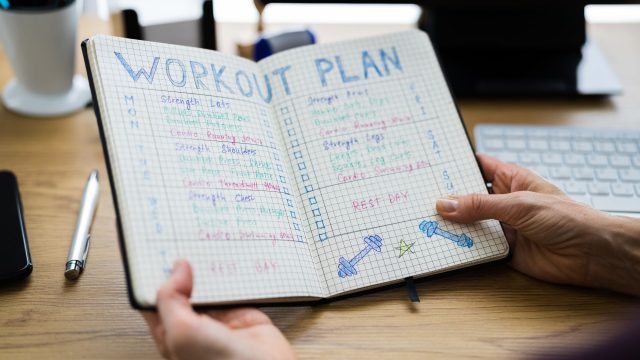Exercise is one of the hardest habits to be consistent with for most people. If it’s something that you struggle with, you are not alone. 70 to 80% of our applicants for one-on-one coaching list how to exercise more consistently as something to work on.
And I’m not immune to this either.
Before 2017, I was in a perpetual loop. I would work out consistently, then fall off the wagon. Then I would work out consistently for a couple of weeks and fall off the wagon again. I was so freaking frustrated by the lack of progress I was seeing in the gym because of that issue.
But in 2017, something changed and I decided to embark on the journey to become Dr. Karin Nordin, Ph.D. If you don’t know what that means, it means that I enrolled in a 4-year long doctoral program. I spent 4 years researching things like habit formation, mindset science, and how we change our behavior.
While learning, researching and doing lab work, I was also applying the techniques I was learning to my own life. That fall, after I started the doctoral program, I felt like I had the most workout consistency I’ve ever had. I was in the gym 5 days a week, and I felt so freaking good! That skill I developed really snowballed over the years. As a result, I was able to compete at a power lifting meet at the end of last year.
In this post, I am going to talk about how to exercise more consistently. Specifically, 3 things I see in clients that might be sabotaging your ability to get to the gym regularly.
1. Your definition of consistency is too rigid
Oftentimes, when we think of consistency, specifically how to exercise more consistently, we imagine working out specific days every week. Maybe it’s the same workout at the gym Monday, Wednesday, Friday at 9:00 AM before work.
Then repeating the next week, over and over and over again. Monday comes and you have a dentist appointment at 9:00 AM, and you can’t make it to that first workout. You don’t replace it somewhere else, and you think to yourself, that’s it, I’m screwed. I’m no longer being consistent.
Because you have so much mind drama wrapped up in the consistency piece, you’re unwilling to be flexible. You’re struggling to develop a cognitive skill that’s called cognitive flexibility.
Cognitive flexibility is our ability to adapt and change with our circumstances and still get to the end result that you want.
Here’s a little quiz question for you: On a scale of 1 to 10, how able are you or how willing are you to do a 15-minute walk if that 45-minute strength training workout you planned didn’t go the right way? I want you to rank yourself on a scale of 1 to 10 in the comments, and that is your current cognitive flexibility score.
Now, cognitive flexibility isn’t a skill you can develop overnight. It’s a skill that takes time, practice, and very strategic exercises in order to increase. However, you can start with this: for one week, try to work out as messily as possible.
Do it in the evening right before you go to bed, even though you hate working out. During that time, take a 5- or 4- or 3-minute walk. Instead of the 30 minutes of running that you planned, be as messy and imperfect as possible for a week, let your brain hate it and react, and see how that goes.
2. You’re not effectively using implementation intentions
All right, let’s talk about point number 2, which is that you’re not effectively using implementation intentions. An implementation intention is a well-researched tool that helps anticipate obstacles and create a plan for overcoming them.
Essentially, what we’re doing when we write an implementation intention is we are telling ourselves, Hey, something probably is going to go wrong, and that’s okay. If it does, I have a plan. Now, the mistake I see people make is, instead of writing implementation intentions or using other evidence-based cognitive tools, people just cross their fingers and they hope that next week will be better news flash.
There’s no such thing as the perfect week, and if you are one of those people who’s waiting for all of the dice to line up in order to get those four workouts in, you are never ever, ever going to get there. You’re going to be waiting forever. You’re going to be waiting forever.
Have you ever sat down at the beginning of your week to anticipate the obstacles that could come up–rain, emotions, workout resistance, planning issues–and create a response ahead of time ?
If you’re a person who’s really struggling to plan and anticipate obstacles, you might want to check out Change Academy.
Change Academy is my monthly membership that is specific for self-help nerds like you who really want to learn the actual science. It's for people who don't want to follow someone's arbitrary structure; don't want to replicate what you've seen on social media that's not going to work for your life. It's for someone who's ready to get nitty-gritty, learn what makes us change, and apply it in their own life. Our theme this month is how to become a frequent exerciser. We'll be going in-depth on how to create implementation intentions- how to write them properly, because most people who come to me after reading self-help books about them are not writing them correctly- and also how to use them as effective tools for following an implementation intention
plan.
3. You mistake the source of your resistance
All right, let’s move to point number three, which is all about you mistaking the source of your resistance. One of the things I see very, very commonly in the general population is that people don’t pay enough attention to their own thoughts. They get derailed from going to the gym, without an awareness as to why. Instead, they think, I’m not motivated or I just don’t want to. Both of these sentences indicate that you don’t have enough awareness of what the actual obstacle might be.
Identify the true source of resistance
So let me ask you: When you’re sitting on the couch scrolling away and you don’t want to get up and go for that run, is it really the run that you’re resisting? Or is it stopping the scroll or is it putting on your workout pants? Or is it figuring out what route you’re going to take in order to feel safe?

MY MOTIVATION HACK
Recently, I applied some of the techniques that we learn in Change Academy to my own life because, of course, I get the research ahead of time. I realized one of my biggest blocks about how to exercise more consistently is getting out of my pajamas and into my workout clothes.
So what did I do? I simply started packing my workout clothes into my gym bag. Then I just grab it and go to the gym in a pair of pajamas with sweatpants over it. For some reason, this makes it so much easier to get out the door. This is just one example of how, when you identify the correct obstacle, that resistance is going to significantly dissipate.
Now, I know a lot of you are probably thinking, uh, Karin, I do have a motivation problem. I’m just not motivated to work out. And if you’re thinking that, you probably have a little misunderstanding about how motivation works, scientifically. Don’t worry, most of the general population does.
Here’s a previous post all about how to motivate yourself according to scientific techniques. So check that out if motivation is something you want to learn more about.
In the meantime, comment if any of these tips and tricks helped you plan how to exercise more consistently.
And stay tuned next week because I’ve got a video coming about how to fit a workout into your routine, and the very best time of day you should work out.




